The connection between birds and dinosaurs is a captivating revelation that reshapes our understanding of Earth’s ancient history.
Over the past few decades, palaeontologists have unearthed a wealth of evidence that overwhelmingly supports the theory that birds are direct descendants of dinosaurs.
This transformative idea has reshaped our perception of these seemingly disparate creatures and highlights the dynamic nature of evolution.
By meticulously piecing together fossil remains, analyzing shared anatomical features, and delving into the genetic intricacies, scientists have unveiled a compelling narrative that traces the evolution of birds from their dinosaurian ancestors.
Why do palaeontologists believe birds are descended from dinosaurs’ insights into the extraordinary journey of life on our planet, bridging the gap between the prehistoric past and the vibrant avian diversity that graces our skies today?

Why Do Palaeontologists Believe Birds Are Descended From Dinosaurs?
Palaeontologists are scientists who study the history of life on Earth through fossils.
They have found many reasons to believe that birds are descended from dinosaurs, especially from a group of theropod dinosaurs that includes Tyrannosaurus rex and Velociraptor.
Here are some of those reasons:
Feathers
Many fossils of non-avian dinosaurs have been found with feathers or feather-like structures, indicating that feathers evolved before the origin of birds.
Some dinosaurs, such as microraptors and Anchiornis, even had long feathers on their arms and legs that formed wings. Feathers are a unique characteristic of birds and their dinosaur ancestors.
Wings

The earliest known bird, Archaeopteryx, had wings that were very similar to those of some small theropod dinosaurs, such as Compsognathus.
Both had long, clawed fingers that supported the wing feathers. The wing bones of birds and theropods also show similar arrangements and proportions.
Flight
Although not all birds can fly, and not all flying animals are birds, flight is a key feature of avian evolution.
Palaeontologists have found evidence that some non-avian dinosaurs, such as microraptors, could also fly or glide using their feathered limbs.
The ability to fly may have evolved several times independently among theropods and birds.
Skeleton
Birds and theropod dinosaurs share many unique skeletal traits, such as a fused collarbone (furcula), a perforated acetabulum (hip socket), a half-moon-shaped wrist bone (semilunate carpal), and a reversed first toe (hallux).
These features are not found in other reptiles or animals and suggest a common ancestry for birds and theropods.
Skull

Birds have a distinctive skull shape that is different from other reptiles. They have a large braincase, a short snout, and no teeth.
However, these features are also seen in some theropod dinosaurs, especially those closely related to birds, such as Troodon and Oviraptor.
These dinosaurs had skulls that were more bird-like than reptile-like, and some even had beaks instead of teeth.
Eggs
Birds are the only living animals that lay hard-shelled eggs, but they inherited this trait from their dinosaur ancestors.
Many fossils of dinosaur eggs have been found, showing that they had similar shapes, sizes, and structures to bird eggs.
Some dinosaur eggs even have preserved embryos inside them, revealing details about dinosaur development and behaviour.
Nests
Birds are known for their elaborate nest-building and brooding behaviours, but they are not the only ones who do so.
Palaeontologists have discovered fossils of dinosaur nests, some with adult dinosaurs sitting on top of them.
These fossils show that some dinosaurs, such as Oviraptor and Citipati, cared for their eggs and young in a similar way to modern birds.
Lungs
Birds have a unique respiratory system that allows them to breathe more efficiently than other animals.
They have lungs that are connected to air sacs that extend into their bones, creating a continuous flow of air through their body.
This system is also found in some theropod dinosaurs, such as Aerosteon and Majungasaurus, indicating that it evolved before the origin of birds.
Metabolism:
Birds have a high metabolic rate that enables them to maintain a constant body temperature (endothermy) and support their active lifestyle.
Although most reptiles are cold-blooded (ectothermic), some evidence suggests that theropod dinosaurs were also warm-blooded or at least had some degree of temperature regulation.
For example, some theropods had insulating feathers or fat deposits that could help them conserve heat.
These are just some of the reasons why palaeontologists believe birds are descended from dinosaurs.
There are many more similarities and connections between these two groups of animals that reveal their evolutionary history.
Birds are not only living dinosaurs but also the most diverse and successful group of dinosaurs ever.
What Evidence Indicates That Birds Evolved From Dinosaurs

There are many pieces of evidence that support the idea that birds evolved from dinosaurs, especially from a group of theropods called maniraptorans. ]
Here are some of them:
Fossil Record
The fossil record provides compelling evidence for the evolutionary link between birds and dinosaurs.
Fossils of feathered dinosaurs, such as Archaeopteryx, showcase a mix of avian and reptilian features.
Discovered in the late 19th century, Archaeopteryx exhibited feathered wings and skeletal traits resembling theropod dinosaurs, establishing a clear transitional form.
Feathered Dinosaurs
The discovery of numerous feathered dinosaur fossils in places like China and Siberia further strengthens the connection between dinosaurs and birds.
These fossils reveal intricate feather structures and colours, pointing to a shared evolutionary lineage.
Similar Bone Structures
Comparative anatomy reveals striking similarities between birds and certain groups of dinosaurs, particularly theropods.
Bones in both groups display analogous structures, such as the arrangement of wrist bones that support wing-like structures in early birds and theropod forelimbs.
Hand-to-Wing Transition
The transformation of dinosaur forelimbs into avian wings can be observed in the fossil record.
For example, some theropods, like Velociraptors, exhibited partially fused wrist bones and a semilunate wrist bone, akin to modern birds. These adaptations facilitated the development of a functional wing.
Hollow Bones
Birds have hollow bones, which reduce weight without compromising strength. Similarly, some theropod dinosaurs also possessed hollow bones.
This adaptation likely helped both birds and certain dinosaurs attain the lightweight frames necessary for flight or agility.
Shared Ancestral Traits
Both birds and certain dinosaur groups share common traits that extend beyond bone structure.
For instance, both have a furcula (wishbone) and possess similar reproductive features, such as laying eggs with hard shells.
Genetic and Molecular Evidence
Recent advancements in genetics and molecular biology have provided additional support for the evolutionary connection between birds and dinosaurs.
Comparative genomic studies have identified shared genetic sequences and regulatory elements involved in the development of feathers and other avian traits.
Collectively, these lines of evidence converge to strongly support the theory that modern birds are the descendants of theropod dinosaurs.
The gradual accumulation of traits over millions of years, as revealed through fossils, anatomical comparisons, and genetic insights, offers a comprehensive understanding of the evolutionary journey from terrestrial dinosaurs to the diverse and adaptive bird species we see today.
FAQ
Paleontologists base this belief on a wealth of evidence, including fossils like Archaeopteryx that exhibit a mix of bird-like and dinosaur-like features, transitional forms showing gradual changes in skeletal structures, and genetic similarities that trace the evolution of feathers and other avian traits.
Fossils of feathered dinosaurs like Microraptor and Anchiornis showcase feathers and anatomical features bridging the gap between dinosaurs and birds.
These fossils, found in China and other locations, provide clear evidence of the evolutionary transition from theropod dinosaurs to early avian forms.
Comparative anatomical studies reveal shared traits, including similar bone structures and the evolution of bird-like features in theropod dinosaurs.
The arrangement of wrist bones, hollow bones for weight reduction, and the presence of a wishbone are examples of features linking these two groups.
Genetic studies have identified common genetic sequences and regulatory elements associated with feather development in both birds and some theropod dinosaurs.
These shared genetic markers provide a molecular perspective on the evolutionary connection between the two groups.
Yes, palaeontologists also consider trace fossils, which show evidence of feather imprints or nesting behaviours in certain dinosaur species.
Additionally, studies of growth rates, bone histology, and metabolic traits reveal similarities between theropod dinosaurs and birds, reinforcing their shared evolutionary heritage.
Conclusion
The captivating story of birds’ evolutionary origins within the realm of dinosaurs stands as a testament to the power of scientific inquiry and discovery.
Through a convergence of fossil findings, anatomical parallels, and genetic revelations, palaeontologists have woven a narrative that demonstrates the remarkable transformation of terrestrial dinosaurs into the aerial wonders we now know as birds.
The legacy of this scientific endeavour extends beyond the confines of biology, inspiring awe and curiosity about the intricate processes that have shaped life on Earth over millions of years.
The theory that birds are descended from dinosaurs not only highlights the interconnectedness of all life but also underscores the beauty of the scientific method in uncovering the hidden threads that link the past to the present.